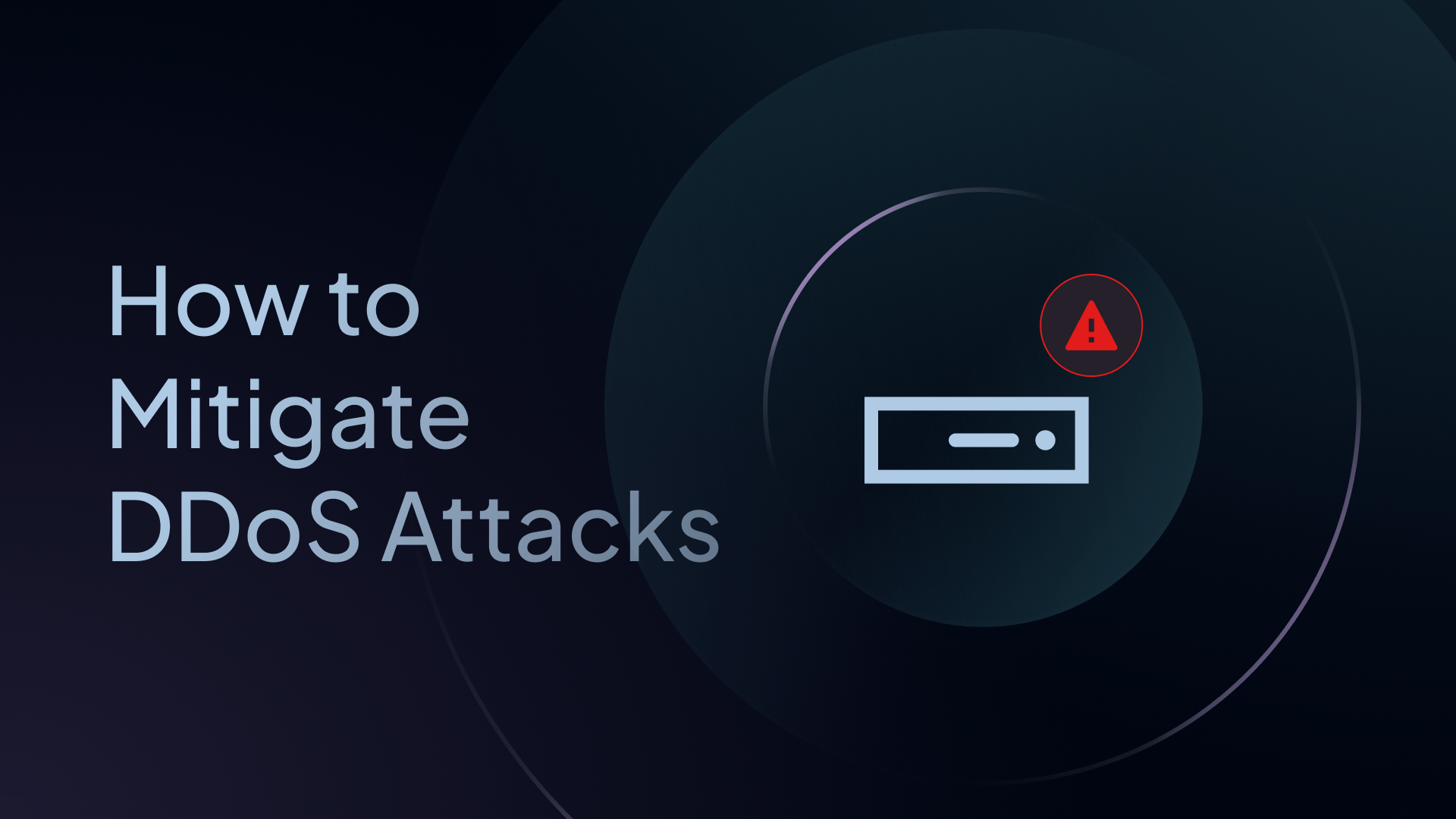How to Mitigate DDoS Attacks with Strategic DNS Configuration
Learn how to configure your DNS layer for resilience and control. Discover best practices and how Control D helps block amplification, filter malicious traffic, and maintain uptime.

Distributed Denial of Service (DDoS) attacks can take your services offline in seconds, but your DNS setup might be the secret weapon you’re overlooking.
In this guide, we’ll break down how strategic DNS configuration helps stop volumetric, application-layer, and DNS-based DDoS attacks before they reach your infrastructure, and how Control D makes it simple to defend at the resolver layer.
What Is a DDoS Attack?
DDoS attacks are designed to overwhelm your server, network, or systems with an avalanche of traffic, making them slow, unreliable, or entirely unavailable. The goal is simple: exhaust your resources.
These attacks come in different forms:
- Volumetric attacks: Flood your network with junk traffic.
- Protocol attacks: These target vulnerabilities in layers like TCP or UDP.
- Application-layer attacks: Aimed at specific services such as HTTP.
- DNS amplification attacks: Use vulnerable DNS servers to flood a target with responses
However, among the most common and destructive are DNS-focused DDoS attacks because DNS sits at the heart of every internet interaction.
Understanding the DNS Layer in DDoS Attacks
The Domain Name System (DNS) translates human-friendly domain names (like example.com) into machine-readable IP addresses. Every email, API call, website visit, and microservice request depends on DNS working correctly, making it an attractive DDoS target.
Common DNS-based DDoS attack vectors include:
- DNS Flood Attacks: Massive volumes of requests are sent to a DNS server, overwhelming its ability to respond.
- DNS Amplification: Attackers use spoofed IPs to get open DNS resolvers to bounce back much larger responses to your network.
- NXDOMAIN Attacks: Flooding DNS servers with requests for non-existent domains, forcing them to waste CPU cycles responding with errors.
- Slow drip DNS attacks: Deliberately slow, low-bandwidth requests that exhaust server resources over time.
When your DNS layer becomes a bottleneck – or worse, goes offline – your entire infrastructure is suddenly unreachable, even if your servers themselves are fine.
Traditional DNS setups, especially those managed in-house or by ISPs, are often ill-equipped to handle these scenarios.
Why Traditional DNS Solutions Fall Short
Most businesses rely on DNS provided by their ISP, web host, or a managed cloud provider. These default DNS configurations often prioritize simplicity and general uptime, not security or flexibility.
Common limitations include:
- Lack of geo-filtering or IP-based rules
- Inability to identify or respond to traffic anomalies
- No control over resolver behavior
- Limited redundancy or global failover capabilities
And once an attack begins, DNS providers often offer little more than “wait and see” responses, or upsell you into expensive “enterprise-grade” plans.
Why DNS Configuration Matters
Your DNS setup is a strategic layer of network control that can either expose or protect you during a DDoS event.
DNS Misconfigurations That Increase Risk:
- Running an open recursive DNS resolver
- Using a single DNS provider with no redundancy
- Hosting your own DNS infrastructure without proper capacity or rate-limiting
- Not enabling DNSSEC (Domain Name System Security Extensions)
- Failing to monitor DNS traffic for anomalies
Strategically configured DNS can provide redundancy, traffic distribution, filtering, and monitoring – all of which are critical for DDoS mitigation.
6 DNS Strategies to Mitigate DDoS Attacks
Let’s look at how strategic DNS decisions can dramatically improve your resilience to DDoS attacks.
1. Anycast-Based DNS Infrastructure
Anycast routing allows DNS queries to be routed to the closest available server in a global network. If one location is overwhelmed or goes offline, traffic is automatically redirected to another.
This makes it harder for an attacker to overwhelm your DNS infrastructure, reduces latency, and improves fault tolerance during high load.
✅ Benefit: Distributes DDoS load globally, increases resiliency, and prevents single-point failures.
2. Granular Traffic Control
An effective DNS layer should let you control who can query your servers, by IP range, ASN, country, or even by user-agent string or query pattern.
✅ Benefit: Stop known bad actors, botnets, or specific geographies from even reaching your infrastructure.
3. Rate Limiting and Query Throttling
DNS resolvers should be configured to detect and limit abnormal query volumes. When a particular source IP is sending an unusually high number of requests, a well-configured DNS can throttle or block that traffic.
✅ Benefit: Prevents DNS flood attacks from overwhelming your resolver while keeping services accessible to normal users during volumetric surges.
4. Filter Malicious Domains at the DNS Layer
DNS solutions allow you to block requests to known malicious domains (e.g., command-and-control servers, malware, and phishing sites) at the resolver level, as well as domains that are suspicious or likely to serve harmful content.
This is often done by leveraging AI-based threat intelligence feeds that help block domains in real time, not only those on known blocklists.
✅ Benefit: Stops malware callbacks and phishing during or after an attack.
5. Logging, Analytics, and Anomaly Detection
DNS logs offer a goldmine of real-time insight. Traffic spikes, abnormal query patterns, or sudden domain activity can serve as early warning signals of a DDoS attack in progress.
Real-time logs help your team differentiate between legitimate usage spikes and attack traffic. They also provide forensic data post-incident.
✅ Benefit: Gives your security team early warning to act before a service outage occurs, and offers forensic data for incident investigation and response.
6. Enable DNSSEC to Prevent Tampering
While DNSSEC doesn’t stop traffic floods, it prevents attackers from hijacking DNS records or redirecting traffic after an attack, a common tactic once systems are stressed. It does this by ensuring DNS query responses are authenticated and haven’t been tampered with.
✅ Benefit: Prevents attackers from cache poisoning or redirecting users to malicious sites.
Control D: Your DNS-First DDoS Mitigation Solution
Control D is a modern, customizable DNS platform designed from the ground up to give you full control over how DNS queries are resolved, filtered, and secured.
It helps organizations deploy secure, resilient, and intelligent DNS configurations that reduce the risk and impact of DDoS attacks.
Here’s how.
🌐 Global Anycast Network
Control D operates a globally distributed, anycast-powered resolver network. This ensures:
- Automatic load distribution during traffic spikes
- No single point of failure
- Resiliency across continents
When a DDoS attack targets a region, Control D automatically routes traffic to other nodes, keeping your services online even during high-volume events.
📍Geo & IP-Based Filtering
Geo-Custom Rules allow you to block queries from entire countries, IP ranges, or ASN blocks. This allows:
- Blocking traffic from known malicious geographies
- Throttling questionable behavior at the network edge
- Preventing bad actors from querying your domains
🧠 Best-in-Class Threat Intelligence
Control D’s malware filter uses AI machine learning to block 99.97% of threats, outperforming competitors such as Google, Cloudflare, and Quad9. This can help you block:
- Known malicious domains
- Newly registered domains (common in DDoS setups)
- Domains used in amplification attacks
This turns your DNS layer into a real-time threat-prevention tool, not just a passive resolver.
📊 Real-Time Logging & Analytics
Control D provides deep DNS visibility via:
- Real-time dashboards
- Historical logs and visualizations
- Anomaly detection via query volume and behavior
This makes it easy to spot attacks as they evolve and respond faster than traditional alerting systems.
🔗 Integration-Friendly, API-Driven
Control D is built for automation. You can:
- Manage DNS rules via API
- Integrate with SIEM or alerting tools
- Automate IP blocking based on external threat feeds
This makes Control D ideal for businesses looking to make DNS part of their automated defense stack.
🧱 Custom Blocklists and Filters
Control D offers 20 filtering categories that help block suspicious or unnecessary domains (e.g., adult content, torrents & piracy, new domains, malware, etc.) that may act as attack vectors or distractions during incident response.
🔒 Encrypted DNS Support
Enforce all modern encryption protocols, such as:
- DNS-over-HTTPS (DoH)
- DNS-over-HTTPS/3 (DoH3)
- DNS-over-TLS (DoT)
- DNSCrypt.
This helps prevent DNS hijacking or surveillance by compromised routers or ISPs.
Final Thoughts
If your business depends on internet availability – whether for customer-facing websites, internal tools, APIs, or third-party integrations – your DNS setup is a critical part of your security infrastructure.
Want a DNS layer that fights back against DDoS attacks?
Control D lets you block malicious traffic, absorb surges with Anycast, detect anomalies in real time, and enforce global filtering policies all without complex agents or third-party appliances.
- ✅ Protect your network’s most overlooked layer
- ✅ Maintain uptime, visibility, and control
- ✅ Reduce your exposure before the next wave hits


